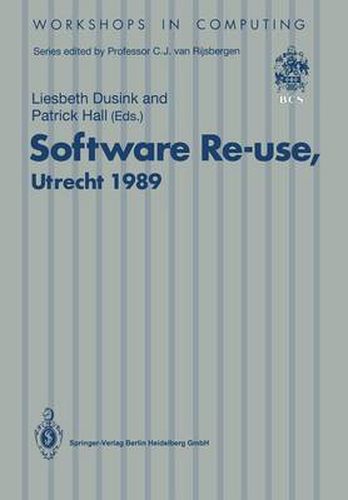Readings Newsletter
Become a Readings Member to make your shopping experience even easier.
Sign in or sign up for free!
You’re not far away from qualifying for FREE standard shipping within Australia
You’ve qualified for FREE standard shipping within Australia
The cart is loading…






This title is printed to order. This book may have been self-published. If so, we cannot guarantee the quality of the content. In the main most books will have gone through the editing process however some may not. We therefore suggest that you be aware of this before ordering this book. If in doubt check either the author or publisher’s details as we are unable to accept any returns unless they are faulty. Please contact us if you have any questions.
This volume contains the papers (revised after the workshop had taken place), together with the reports of the parallel sessions, from the Software Re-use Workshop, held in Utrecht from 23-24 November 1989. Members of the leading research teams from Europe were invited to the workshop to present short papers. The various researchers’ approaches were debated in the parallel sessions: on domain analysis, on component engineering (including reverse engineering), and on the development of software from re-usable components. Re-use of software may be defined as a means to support the construction of new programs using, in a systematic way, existing designs, design fragments, program texts, documentation, or other forms of program representation. This excludes porting and maintenance because these activities are based on keeping the same software in a changing (hardware or software) environment. Software re-use is sometimes regarded as a solution to the software crisis , by both improving software quality and reducing costs and timescales. However, although the idea is simple, there are technical problems to be overcome, including: standard description of components, methods for generic components, use for reverse engineering, library organization for easy retrieval, methods for design using components and how to use knowledge of the underlying domains. The book starts with an introduction to software re-use, and has a comprehensive bibliography merged from those accumulated at Delft and Brunel. The book provides a summary of software re-use, which should be of interest to software engineers and postgraduate students who need a rapid introduction to software re-use and its main research issues, together with the results of current research from teams across Europe. This book of proceedings on computer science, software engineering and information systems is intended for researchers in industry and academia, software developers in industry and postgraduate students.
$9.00 standard shipping within Australia
FREE standard shipping within Australia for orders over $100.00
Express & International shipping calculated at checkout
This title is printed to order. This book may have been self-published. If so, we cannot guarantee the quality of the content. In the main most books will have gone through the editing process however some may not. We therefore suggest that you be aware of this before ordering this book. If in doubt check either the author or publisher’s details as we are unable to accept any returns unless they are faulty. Please contact us if you have any questions.
This volume contains the papers (revised after the workshop had taken place), together with the reports of the parallel sessions, from the Software Re-use Workshop, held in Utrecht from 23-24 November 1989. Members of the leading research teams from Europe were invited to the workshop to present short papers. The various researchers’ approaches were debated in the parallel sessions: on domain analysis, on component engineering (including reverse engineering), and on the development of software from re-usable components. Re-use of software may be defined as a means to support the construction of new programs using, in a systematic way, existing designs, design fragments, program texts, documentation, or other forms of program representation. This excludes porting and maintenance because these activities are based on keeping the same software in a changing (hardware or software) environment. Software re-use is sometimes regarded as a solution to the software crisis , by both improving software quality and reducing costs and timescales. However, although the idea is simple, there are technical problems to be overcome, including: standard description of components, methods for generic components, use for reverse engineering, library organization for easy retrieval, methods for design using components and how to use knowledge of the underlying domains. The book starts with an introduction to software re-use, and has a comprehensive bibliography merged from those accumulated at Delft and Brunel. The book provides a summary of software re-use, which should be of interest to software engineers and postgraduate students who need a rapid introduction to software re-use and its main research issues, together with the results of current research from teams across Europe. This book of proceedings on computer science, software engineering and information systems is intended for researchers in industry and academia, software developers in industry and postgraduate students.